Contents
Radishes are the earliest spring vegetable, loved by adults and children. Early radish appears in our diet in the spring, and along with the first greens, it provides the body weakened after winter with the necessary vitamins. Each vegetable grower considers it his duty to grow a bed of a healthy product in his own garden, because growing radishes does not present any difficulties. It is undemanding to conditions, it does not need complex care, besides, it is possible to sow radishes in open ground very early, as soon as the snow melts.
Features of growing radishes
Radish is considered an unpretentious and cold-resistant crop, however, in order for its cultivation in the garden to be successful, it is necessary to take into account some features of the culture. There are two main factors that affect the yield of radishes – this is good humidity and the right temperature. If the plants are provided with these conditions, then vitamin root crops can be grown throughout the season, while receiving a bountiful harvest.
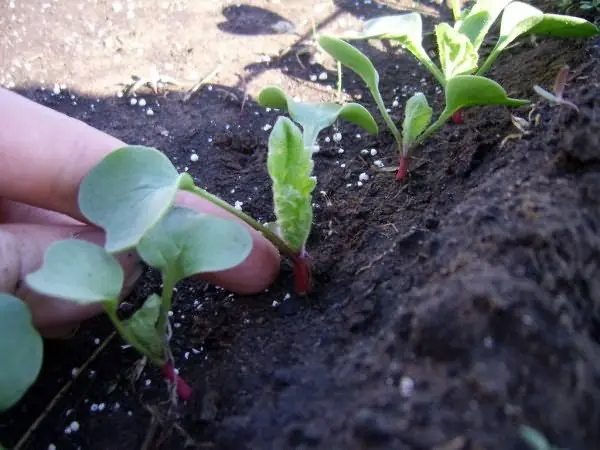
The moisture content of the soil in which radishes are grown should always be maintained at the same level. Drying out of the soil, just like stagnant moisture, negatively affects the quality of root crops, so you should water the bed regularly, at regular intervals, and make sure that the ground is always wet. Uneven watering can also harm plants: due to a lack of moisture, the growth of root crops slows down, they become coarse and not juicy, and if the bed is watered abundantly after a drought, the fruits may crack.
As for temperature, radish seeds are able to germinate at a soil temperature of +2 °C, so an early variety can be sown in late March – early April, however, plants need a temperature of +15-18 °C for further development. This is the optimal degree at which root crops grow to a normal size and have good taste characteristics. A higher soil temperature leads to a rapid build-up of tops to the detriment of the growth of root crops – radishes become rough, loose and bitter. For this reason, it is not recommended to grow the crop in the middle of summer (in July), when the air temperature reaches +25 ° C and above.
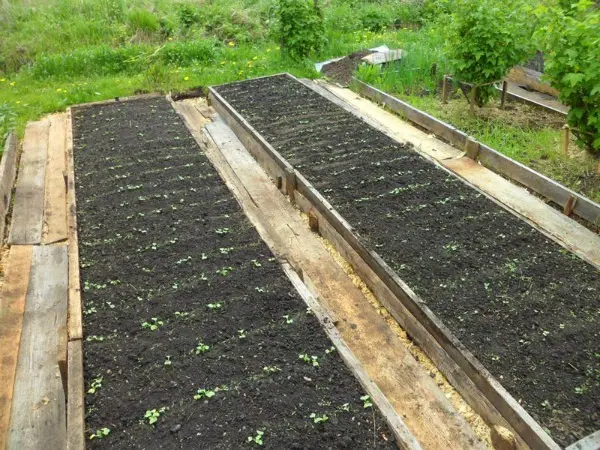
Radish is photophilous, however, to grow it, you do not need a long daylight hours. If daylight exceeds 12 hours, plants begin to produce flower stalks. Therefore, it is recommended to grow radishes outdoors in spring or autumn, when the daylight hours are not too long and the soil temperature is not very high.
To obtain high-quality and tasty root crops, it is better to sow an early variety of radish with a ripening period of 20-30 days, and it is pointless to plant late varieties that ripen in 45-60 days in the spring, since the root will not have time to form before summer.
To a certain extent, the yield depends on the composition of the soil. Radishes like fertile, well-draining soil that is neutral to slightly acidic. In heavy soil, with high acidity, root crops get sick, rot, become irregular in shape and lose their density and taste. Many vegetable growers are convinced that high beds should be erected for growing radishes – this will allow you to add good loose soil, and also make it easier to care for the plants.
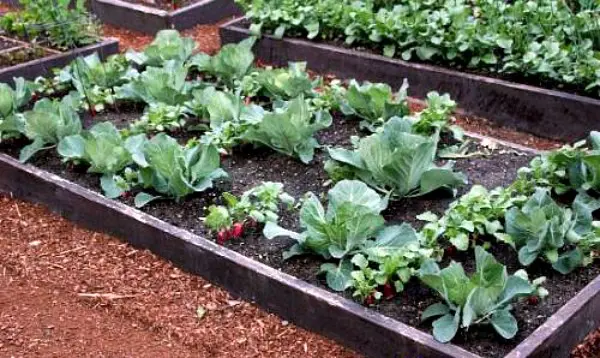
When sowing radishes, you should pay attention to the predecessors of the crop. It will not be possible to grow good root crops if in the previous year they grew in the garden: cabbage (any variety), watercress, turnip, radish or horseradish. Conversely, it is recommended to grow radishes after legumes, nightshade crops (potatoes, tomatoes, eggplant), cucumbers.
It is good to sow radishes in a bed intended for tomatoes – while seedlings are being grown, several crops of radishes can be obtained from the site.
Soil preparation
The site where the radish will be grown must be prepared in advance. For spring sowing, the bed is prepared in the fall; for sowing before winter, soil preparation should begin at the end of summer.
A place for a garden bed should be chosen moderately open to the sun and protected from the wind. As mentioned above, a high bed is best suited for radishes.
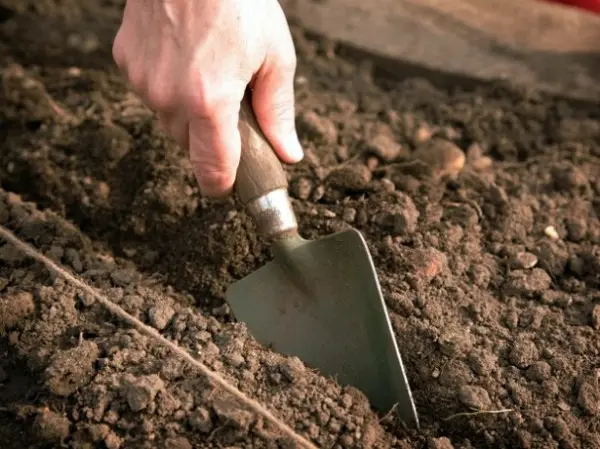
The selected area is fertilized with humus (2–3 kg / 1 m²), compost, potassium-phosphorus mixtures can also be added, and they are dug up to about a depth of 20–25 cm. If the soil is acidic, it must be limed. A little river sand, peat should be added to heavy soil – these materials will increase its drainage properties. The dug-up bed is covered with a film, the shelter is fixed along the edges with stones so that it is not blown away by the wind, and left in this state until spring. In the same way, a bed is prepared for winter sowing.
Landing
If the cultivation of radishes occurs in the spring, then as soon as the snow melts, the film is removed, and the soil surface is slightly loosened. Further along the length of the beds, several long, shallow (up to 5 cm) furrows are made so that the distance between them is 10–15 cm. The bottom of each furrow is well watered, and when the water is slightly absorbed, seeds are sown. Ideally, they should be planted 4–5 cm apart, but most vegetable growers prefer to sow thicker and then thin out the rows. After sowing, each hole is covered with earth, the surface of the beds is leveled and again covered with a film.
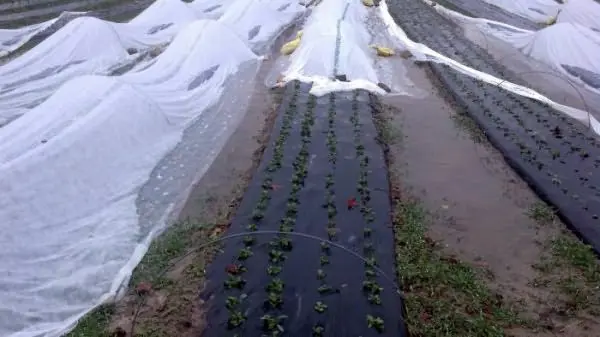
Further care will consist in removing the shelter during the day and returning it to the bed at night until the threat of night frost has passed and the soil has warmed up to a temperature of + 12-15 ° C.
Planting radishes for the winter is carried out according to the same technology, with the only difference that the seeds are planted in dry soil, because in moist soil they can germinate before the onset of winter. In the spring, it will only be necessary to free the bed from the film, and provide the necessary care. Winter sowing has one significant advantage over spring sowing – it allows you to grow and harvest the first crop 2 weeks earlier.
Video “We plant radishes in the ground”
This video will demonstrate the process of sowing radish seeds outdoors in the spring.
Care
As you know, only proper care of the beds helps to grow a good crop of radishes. Proper care in this case consists in the simplest activities: watering, loosening row spacing and removing weeds. If the seeds were sown densely, then as soon as the plants have a couple of true leaves, they should be thinned out, removing the weakest ones, and leaving the strongest shoots at a distance of 4–5 cm.
Irrigation should be given special attention, since the growth and yield of the crop depends on soil moisture. If there is no rain, watering should be done 2-3 times a week at regular intervals. In hot weather, it is recommended to sprinkle the beds. It is necessary to ensure that the soil is always moistened by 75–80%. Only at this level of humidity can juicy, crunchy and moderately bitter root crops be grown.

Further care is to maintain cleanliness in the garden. Once every 8-10 days it should be weeded. It is necessary to loosen after each watering not very deep, since the roots are close to the surface and can easily be damaged. A bed with radishes can be mulched with any organic material – this measure will protect the soil from drying out, weed germination and simplify planting care.
It is necessary to feed radishes only if they are planted before winter, or the varieties have a late ripening period. As a fertilizer, humus or compost can be applied, but only in small quantities. Some vegetable growers use saltpeter, superphosphate, but since they contain nitrogen, the use of such fertilizers is not always justified, since nitrogen contributes to the accumulation of nitrates. Early varieties of radishes planted in spring can be grown without additional feeding – as a rule, fertilizers applied during soil preparation are sufficient for their growth.

Fighting diseases and pests
Caring for radishes also involves pest control. Since the growing season of radishes is short, and falls mainly in the cool season, there are not so many pests. The main enemies of plants are the cruciferous flea, the danger of which lies in the fact that it eats the very first and young leaves of radishes, and aphids – these insects appear in late spring and suck the juices from young leaves.
You can get rid of pests with a solution of ash and laundry soap (2 cups of ash and 50 g of soap / 10 liters of water). The solution is sprayed with a bed about 1 time per week until the tops grow. Alternatively, the ashes can simply be scattered between the plants – it’s okay if a little fertilizer gets on the leaves.
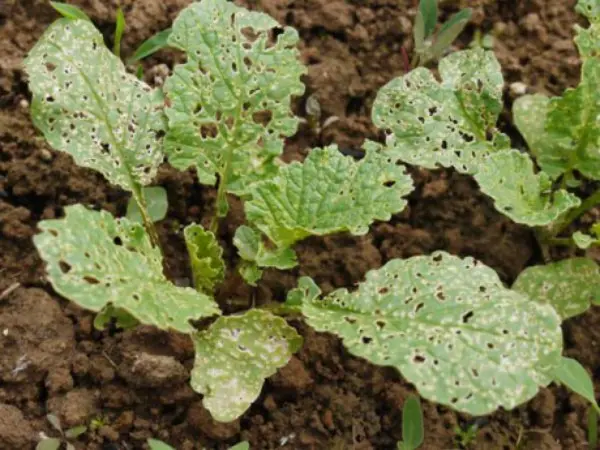
Pests such as slugs and bears can feast on root crops. But since it is not recommended to introduce insecticides into the soil, since the radish quickly accumulates harmful substances and, due to the short growing season, does not have time to get rid of them, it is possible to deal with enemies only by folk methods. It has been noticed that these pests do not like lettuce, so vegetable growers came up with the idea of sowing it in one row along with radishes. Since the lettuce root is very small, the plants do not interfere with each other, and it is possible to grow both crops at the same time.
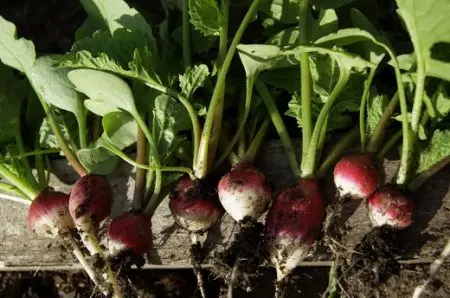
Diseases of radishes are very rare. Here, special care is practically not required, since it can only get sick if it is grown in late spring or early summer. Problems such as yellowing of leaves and rotting of root crops most often concern mid-season varieties, and there is only one reason for this – improper watering.
Leaves may turn yellow from lack of moisture, while putrefactive processes occur from its excess. Adjusting your watering schedule can solve this problem and allow you to continue growing quality and tasty radishes.
Video “Fighting the mole on the site”
This video is about how you can deal with a mole that spoils radish plantings.









